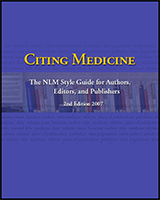Box 56Names in non-roman alphabets (Cyrillic, Greek, Arabic, Hebrew, Korean) or
character-based languages (Chinese, Japanese)
Romanization, a form of transliteration, means using the roman (Latin)
alphabet to represent the letters or characters of another alphabet. A
good authority for romanization is the ALA-LC
Romanization Tables.
Romanize names in Cyrillic (Russian, Bulgarian, etc.), Greek,
Arabic, Hebrew, Korean, or character-based languages, such as
Chinese and Japanese
Capitalize only the first letter of romanized names if the
original initial is represented by more than one letter
Georgios Th.
Tsakalos
becomes Tsakalos
GTh
Ignore diacritics, accents, and special
characters in names. This rule ignores some
conventions used in non-English languages to
simplify rules for English-language
publications.
Treat two or more letters printed as
a unit (ligated letters) as if they are two
letters
æ treated
as ae
œ treated
as oe
